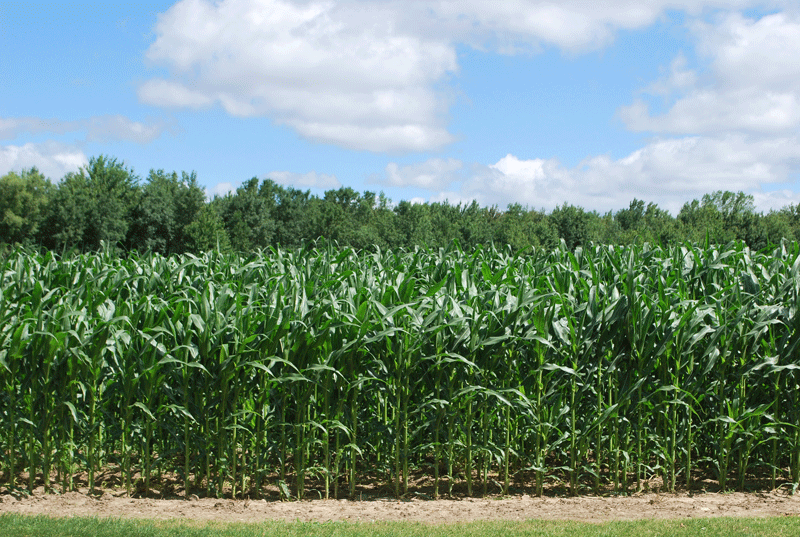Growth in the west
CORN, SOYBEAN ACRES INCREASING ACROSS THE PRAIRIES
HISTORICALLY, WESTERN CANADA has been a major producer of wheat and canola, growing 90 percent of all wheat in Canada and 99 percent of Canada’s canola. The success of these crops, coupled with the increasing market demands for corn and soybeans, make the Prairies an attractive region for expansion.

Corn and soybeans are becoming viable options for western farmers thanks to the breeding of new varieties and advancements in technology. Previously, the Prairie provinces, especially Saskatchewan and Alberta, were unsuitable for producing corn and soybeans due to climate, latitude, and the length of the growing season. This new development has been the topic of discussion at several agricultural conferences in the past year, including the 2013 Grain Industry Symposium hosted by Grain Growers of Canada and the Canada Grains Council.
“Genetic modification was a game changer,” said Dr. William Wilson, Professor in the Department of Agribusiness and Applied Economics at North Dakota State University during his presentation at the Symposium. “It has resulted in changing geography and technology growth rates. Genetic modification and faster maturing varieties have moved the corn belt north in Canada.”
Wilson says global demand growth has exceeded productivity growth in recent years, but breeding and genetic modification ensure greater productivity more quickly. Money and resources drive change, he says, and new traits like drought resistance and nitrogen use efficiency widen the area in which the crops can be grown.
CORN
Corn production is on the rise for both acres seeded and yield. According to Mike Nailor, Corn and Soybean Business Lead for Monsanto Canada, the ability to grow corn and soybeans in Western Canada is the next area to target for expansion.
“Land currently growing corn has reached maximum productivity,” explained Nailor during the Symposium. “Enhanced ability to produce corn and soybeans in the west is a tremendous opportunity for the area and for markets.”
Canada is a net importer of corn, with domestic supply covering 85 percent of usage. Corn imports have declined for over a decade as production in the country has steadily increased to meet increased demands from markets. Though the majority of corn is used for animal feed – ethanol and human food products remain a large market.
Seed developers see value in producing seed corn that will be viable in the west. Monsanto is aiming to breed corn varieties that mature in as little as 70 days, an improvement on its current early-maturing variety that requires 76 days.
Growing corn on the Prairies is not without its challenges. There can be significant input costs associated with growing corn, including costly new equipment needed for both seeding and harvesting. Increased storage is also required for both equipment and grain. Weather, as always, can be an issue, with the Prairies experiencing different conditions than the “corn belt” in eastern Canada.
SOYBEANS
The potential for greater economic returns through increasing prices and demand are a huge driver of the expansion of soybean production areas. Identity Preserved non- genetically modified varieties add further value to crops, with premiums ranging between $0.50 and $3.00 per bushel.
“Canadian soybeans are the fourth-largest agri-food export in Canada, with increases every year,” said Barry Senft, CEO of Grain Farmers of Ontario. “New markets such as biodiesel as well as expanding crush facilities are creating demand for Canadian soybeans.”
Senft noted, at this time, there is less selection for farmers needing a shorter-season seed in order to grow in the Prairies for both corn and soybeans, although some shorter season varieties have been developed.
“Currently in Manitoba there are nine glyphosate resistant and two conventional shorter season varieties of soybeans available for commercial production. In 2013, six additional varieties were tested for registration. To put that in context, more than 200 mid to long season varieties are commercially available in Ontario.”
New early maturing, high yield, flower time cold tolerant, and disease and pesticide resistant types of soybeans are continuing to be developed by researchers and breeders.
FUTURE OPPORTUNITIES
The expansion of corn and soybean crops into the west may worry some farmers in Ontario, but according to Senft, this growth could be a good thing.
“In regards to corn, even with additional corn production in western Canada, when you look at the North American volumes of corn, it will not have a significant impact from a macro perspective. It may limit US exports into Western Canada but that should not have any effect in Ontario. Soybeans grown in the west will likely be commodity soybeans rather than Identity Preserved. This may create an opportunity for Ontario producers to increase IP production with a premium. The high-quality, identity-protected varieties grown in Ontario are in demand, and our growers will be able to take advantage of this niche market.” •






















